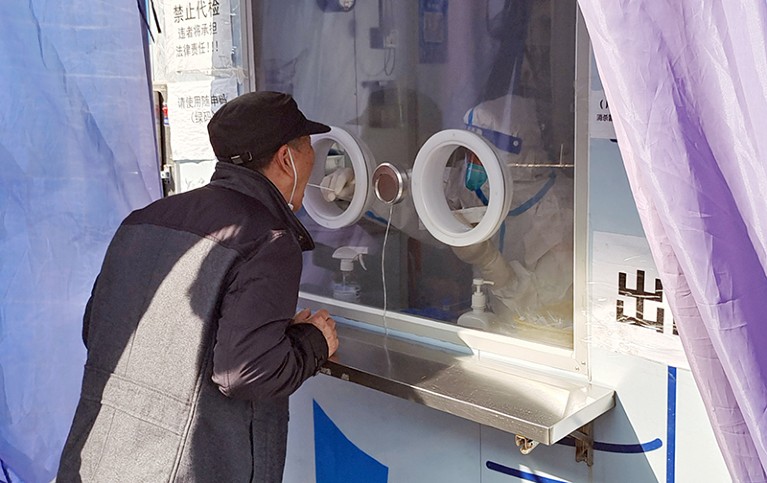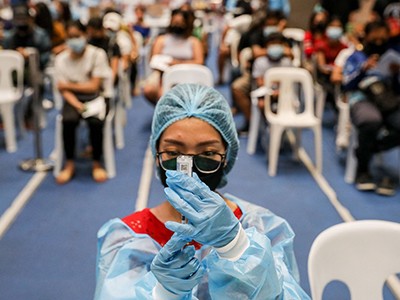[ad_1]

A kiosk in Shanghai, China, offers free SARS-CoV-2 testing.Credit: CFOTO/Future Publishing via Getty
Three years into the pandemic, the immune systems of the vast majority of humans have learnt to recognize SARS-CoV-2 through vaccination, infection or, in many cases, both. But just how quickly do these types of immunity fade?
New evidence suggests that ‘hybrid’ immunity, the result of both vaccination and a bout of COVID-19, can provide partial protection against reinfection for at least eight months1. It also offers greater than 95% protection against severe disease or hospitalization for between six months and a year after an infection or vaccination, according to estimates from a meta-analysis2. Immunity acquired by booster vaccination alone seems to fade somewhat faster.
But the durability of immunity is much more complex than the numbers suggest. How long the immune system can fend off SARS-CoV-2 infection depends not only on how much immunity wanes over time but also on how well immune cells recognize their target. “And that has more to do with the virus and how much it mutates,” says Deepta Bhattacharya, an immunologist at the University of Arizona College of Medicine in Tucson. If a new variant finds ways to escape the existing immune response, then even a recent infection might not guarantee protection.
Omicron era
Omicron has presented just such a scenario. In late 2021 and early 2022, the main Omicron subvariants that were causing infections were BA.1 and BA.2. By mid-2022, the BA.5 wave was gathering strength in some countries, raising the prospect that those who’d already had one round of Omicron could soon be exposed to another. Data are now providing a sense of the risk of reinfection over time.
In one study1, researchers looking at Portugal’s national database of infections studied vaccinated people who became infected during the BA.1/BA.2 wave. Analysis showed that 90 days after an infection, this population had high immune protection — their risk of becoming infected with BA.5 was just one-sixteenth that of people who had been vaccinated but never infected. After that, hybrid immunity against infection declined steeply for a few months and then stabilized, ultimately providing protection for eight months after infection, the duration of the study.
What the Omicron wave is revealing about human immunity
Another study3 looked at 338 vaccinated health-care workers in Sweden, some of whom had also had a prior SARS-CoV-2 infection. The authors found that workers with hybrid immunity had some level of protection against infection with BA.1, BA.2 and BA.5 for at least eight months. Swabbing of these workers’ noses revealed high levels of ‘mucosal’ antibodies, which are thought to be a better shield against infection than antibodies that circulate in the blood.
A study4 in Qatar compared the infection risks of people who had never caught SARS-CoV-2 with those of people who’d had a previous infection with Omicron or an earlier variant. Both groups included vaccinated and unvaccinated individuals. The results show that more recent infections provide greater protection than older ones in all cases. But because the virus kept evolving, the authors couldn’t untangle whether those differences were because of waning immunity, the virus’s growing ability to evade the immune response or, more likely, a combination of the two.
Infection reprieve
Taken together, the studies suggest that hybrid immunity provides some protection against infection for at least seven or eight months, and probably longer. “That’s pretty good,” says Charlotte Thålin, an immunologist at the Karolinska Institute in Stockholm and an author of the Swedish study.
Other data suggest that in people whose immunity arises only from vaccination, a booster dose provides relatively short-lived protection against infection. Researchers in Israel studied more than 10,000 health-care workers who had not previously been infected; all received either three or four doses of the vaccine made by Pfizer and BioNTech5. The authors found that the fourth dose’s efficacy against infection fell rapidly. In fact, after four months, the fourth dose was no better than three doses at preventing infection.
Immunity against Omicron from breakthrough infection could be a matter of timing
However, “we are talking just about what we call relatively mild disease”, says study co-author Gili Regev-Yochay, an epidemiologist at Sheba Medical Center Tel Hashomer in Ramat Gan, Israel. None of the people in the study developed severe COVID-19.
What about those who haven’t been vaccinated? Another study6 in Qatar suggests that if the virus doesn’t change, infection-based immunity against reinfection can last up to three years. But that immunity can fade faster if the virus mutates. The authors studied data from unvaccinated people who were infected with a pre-Omicron variant. Fifteen months later, those infections were less than 10% effective at protecting against Omicron infection. And it is much riskier to rely on immunity from infection than to get immunized.
But it’s nearly impossible to apply the study results to predict an individual’s risk of becoming infected in future. Immunity depends on a variety of factors, including genetics, age and sex. And past risk of infection isn’t necessarily a good predictor of the risk of future infection, because new variants are continually arising.
Booster break
How growing global hybrid immunity will affect the timing and frequency of infection surges isn’t yet clear. Neither is it clear how this will influence health officials’ decisions about when to offer future booster doses.
For people who are at high risk of developing severe COVID-19, it might make sense to get boosters frequently. Younger individuals without any risk factors who live in regions where the virus has been circulating freely “may already have very significant protection that may not require as frequent boosters”, says Luís Graça, an immunologist in the Faculty of Medicine at the University of Lisbon and a co-author of the Portuguese study. Another option might be to give a booster when antibody levels fall below a certain threshold, says Regev-Yochay.
Thålin understands that how frustrating the caveats and uncertainty can be, but says that researchers aren’t likely to pin down an answer anytime soon. “The virus is evolving so fast,” she says. “What’s true today might not be true tomorrow.”
[ad_2]
Source link



